Numerical Study on Indoor Environmental Quality in a Room Equipped with a Combined HRV and Radiator System
Abstract
:1. Introduction
2. Materials and Methods
2.1. Physical Model
2.2. CFD Modelling
2.2.1. Governing Equations
2.2.2. The Local Age of the Air
2.2.3. Transport Model for Gaseous Contaminants
2.2.4. Thermal Comfort Analysis
2.2.5. Grid Generation
2.2.6. Boundary Conditions
2.3. Validation of the Numerical Model
3. Results and Discussions
3.1. Airflow and Temperature Distribution
3.2. Air Quality Indices and Ventilation Efficiency
3.3. Analysis of Thermal Comfort Condition
4. Conclusions
Author Contributions
Funding
Conflicts of Interest
Nomenclature
| ACPH | air change per hour (h−1) | Greek symbols | |
| ACE | air change efficiency (%) | ε | turbulence dissipation (m2 s−3) |
| cp | heat capacity of air (J kg−1 K−1) | κ | turbulence kinetic energy (m2 s−3) |
| C | contaminant concentration (kg m−3) | μ | dynamic viscosity (kg m−1 s−1) |
| dimensionless contaminant concentration | diffusion coefficient (m2 s−1) | ||
| D | diffusion coefficient (m2 s−1) | ρ | air density (kg m−3) |
| DR | draught rate (%) | age of the air (s) | |
| e | energy per unit mass (J kg−1) | room-averaged age of the air (s) | |
| emission rate of contaminants (kg s−1) | shear stress (Pa) | ||
| E | strain rate (s−1) | ventilation efficiency | |
| g | magnitude of the acceleration (m s−2) | arbitrary scalar | |
| Gf | volumetric fresh air (m3 s−1) | ψ | factor related to air velocity |
| h | specific enthalpy (J kg−1) | ||
| I | turbulence intensity | Subscripts | |
| J | diffusion flux (kg m−2 s−1) | air | refers to air |
| k | thermal conductivity (W m−1 K−1) | ave | average value |
| n | number of occupants | CO2O | refers to carbon dioxide |
| r | CO2 generation rate per person | CH2O | refers to formaldehyde |
| p | pressure (Pa) | eff | effective value |
| PMV | predicted mean vote | ext | external |
| PPD | percent person dissatisfied (%) | i | i-th |
| Re | Reynolds number | in | inlet |
| S | source term | mix | mixture |
| Sc | Schmidt number | opr | operative |
| t | time (s) | out | outlet |
| temperature (K) | rad | refers to radiation | |
| volume-averaged temperature (K) | t | refers to turbulence | |
| U | thermal transmittance (W m−2 K−1) | wall | refers to wall |
| velocity magnitude (m s−1) | win | refers to window | |
| local mean velocity magnitude (m s−1) | y | refers to distance from wall | |
| volume-averaged velocity (m s−1) | refers to arbitrary scalar | ||
| V | volume (m3) | 0 | reference value |
| x | horizontal coordinate (m) | ||
| y | horizontal coordinate/distance from wall (m) | ||
| Y | local mass fraction of species | ||
| z | vertical coordinate (m) |
References
- European Parliament. The Directive 2010/31/EU of the European Parliament and of the Council of 19 May 2010 on the Energy Performance of Buildings (EPDB); European Parliament: Brussels, Belgium, 2010. [Google Scholar]
- Omer, A. Renewable building energy systems and passive human comfort solutions. Renew. Sustain. Energy Rev. 2008, 12, 1562–1587. [Google Scholar] [CrossRef]
- Ye, X.; Kang, Y.; Yang, F.; Zhong, K. Comparison study of contaminant distribution and indoor air quality in large-height spaces between impinging jet and mixing ventilation systems in heating mode. Build. Environ. 2020, 160, 106159. [Google Scholar] [CrossRef]
- Franco, A.; Schito, E. Definition of optimal ventilation rates for balancing comfort and energy use in indoor space using CO2 concentration data. Buildings 2020, 10, 135. [Google Scholar] [CrossRef]
- Mancini, F.; Nardecchia, F.; Groppi, D.; Ruperto, F.; Romeo, C. Indoor environmental quality analysis for optimizing energy consumptions varying air ventilation rates. Sustainability 2020, 12, 482. [Google Scholar] [CrossRef] [Green Version]
- Zhong, L.; Yuan, J.; Fleck, B. Indoor environmental quality evaluation of lecture classrooms in an institutional building in a cold climate. Sustainability 2019, 11, 6591. [Google Scholar] [CrossRef] [Green Version]
- Mutlu, M. Numerical investigation of indoor air quality in a floor heated room with different air change rates. Build. Sim. 2020, 13, 1063–1075. [Google Scholar] [CrossRef]
- Ganesh, G.; Sinha, S.; Verma, T. Numerical simulation for optimization of the indoor environment of an occupied office building using double-panel and ventilation radiator. J. Build. Eng. 2020, 29, 101139. [Google Scholar] [CrossRef]
- Chiesa, G.; Cesari, S.; Garcia, M.; Issa, M.; Li, S. Multi sensor IoT platform for optimising IAQ levels in buildings through a smart ventilation system. Sustainability 2019, 11, 5777. [Google Scholar] [CrossRef] [Green Version]
- Dodoo, A.; Gustavsson, L.; Sathre, R. Primary energy implications of ventilation heat recovery in residential buildings. Energy Build. 2011, 43, 1566–1572. [Google Scholar] [CrossRef]
- Bayoumi, M. Method to integrate radiant cooling with hybrid ventilation to improve energy efficiency and avoid condensation in hot, humid environments. Buildings 2018, 8, 69. [Google Scholar] [CrossRef] [Green Version]
- Zhang, C.; Pomianowski, M.; Heiselberg, P.; Yu, T. A review of integrated radiant heating/cooling with ventilation systems—Thermal comfort and indoor air quality. Energy Build. 2020, 223, 110094. [Google Scholar] [CrossRef]
- Li, B.; Wild, P.; Rowe, A. Performance of a heat recovery ventilator coupled with an air-to-air heat pump for residential suites in Canadian cities. J. Build. Eng. 2019, 21, 343–354. [Google Scholar] [CrossRef]
- White, J.; Gillott, M.; Wood, J.; Loveday, D.; Vadodaria, K. Performance evaluation of a mechanically ventilated heat recovery (HRV) system as part of a series of UK residential energy retrofit measures. Energy Build. 2016, 110, 220–228. [Google Scholar] [CrossRef]
- Foda, E.; El-Hamalawi, A.; Dréau, J.L. Computational analysis of energy and cost efficient retrofitting measures for the French house. Build. Environ. 2019, 175, 106792. [Google Scholar] [CrossRef]
- Calisir, T.; Yazar, H.; Baskaya, S. Thermal performance of PCCP panel radiators for different convector dimensions—An experimental and numerical study. Int. J. Therm. Sci. 2019, 137, 375–387. [Google Scholar] [CrossRef]
- Ferrantelli, A.; Võsa, K.V.; Kurnitski, J. Optimization of radiators, underfloor and ceiling heater towards the definition of a reference ideal heater for energy efficient buildings. Appl. Sci. 2018, 8, 2477. [Google Scholar] [CrossRef] [Green Version]
- Assimakopoulos, M.; Masi, R.D.; Fotopoulou, A.; Papadaki, D.; Ruggiero, S.; Semprini, G.; Vanoli, G. Holistic approach for energy retrofit with volumetric add-ons toward NZEB target: Case study of a dormitory in Athens. Energy Build. 2020, 207, 109630. [Google Scholar] [CrossRef]
- Chen, Q. Comparison of different k-ε models for indoor airflow computations. Num. Heat Trans. Part B Fundam. 1999, 28, 4391–4409. [Google Scholar]
- Jahanbin, A.; Zanchini, E. Effects of position and temperature-gradient direction on the performance of a thin plane radiator. Appl. Therm. Eng. 2016, 105, 467–473. [Google Scholar] [CrossRef]
- Semprini, G.; Jahanbin, A.; Pulvirenti, B.; Guidorzi, P. Evaluation of thermal comfort inside an office equipped with a fan coil HVAC system: A CFD approach. Future Cities Environ. 2019, 5, 1–10. [Google Scholar] [CrossRef]
- Chanteloup, V.; Mirade, P. Computational fluid dynamics (CFD) modelling of local mean age of air distribution in forced-ventilation food plants. J. Food Eng. 2009, 90, 90–103. [Google Scholar] [CrossRef]
- Salthammer, T. Data on formaldehyde sources, formaldehyde concentrations and air exchange rates in European housings. Data Brief 2019, 22, 400–435. [Google Scholar] [CrossRef] [PubMed]
- Tian, L.; Lin, Z.; Wang, Q. Comparison of gaseous contaminant diffusion under stratum ventilation and under displacement ventilation. Build. Environ. 2010, 45, 2035–2046. [Google Scholar] [CrossRef]
- ASHRAE. Thermal Environmental Conditions for Human Occupancy; ASHRAE STANDARD 55; ASHRAE: Atlanta, GA, USA, 2013. [Google Scholar]
- ISO 7730. Moderate Thermal Environment—Determination of the PMV and PPD Indices and Specification of the Conditions for Thermal Comfort; International Organization for Standardization: Geneva, Switzerland, 2005. [Google Scholar]
- Johnson, D.L.; Lynch, R.A.; Floyd, E.L.; Wang, J.; Bartels, J.N. Indoor air quality in classrooms: Environmental measures and effective ventilation rate modeling in urban elementary schools. Build. Environ. 2018, 136, 185–197. [Google Scholar] [CrossRef]
- ASHRAE. Ventilation for Acceptable Indoor Air Quality; ASHRAE Standard 62.1; ASHRAE: Atlanta, GA, USA, 2016. [Google Scholar]


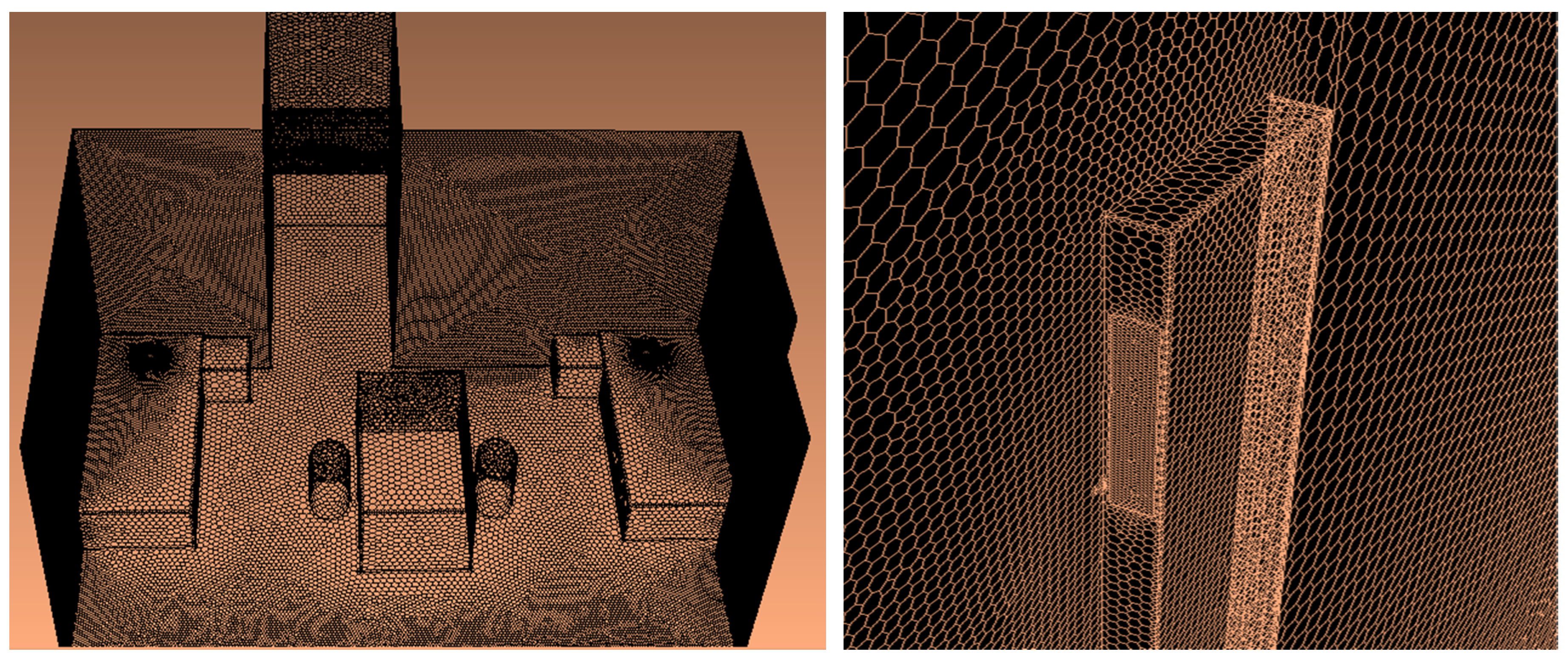
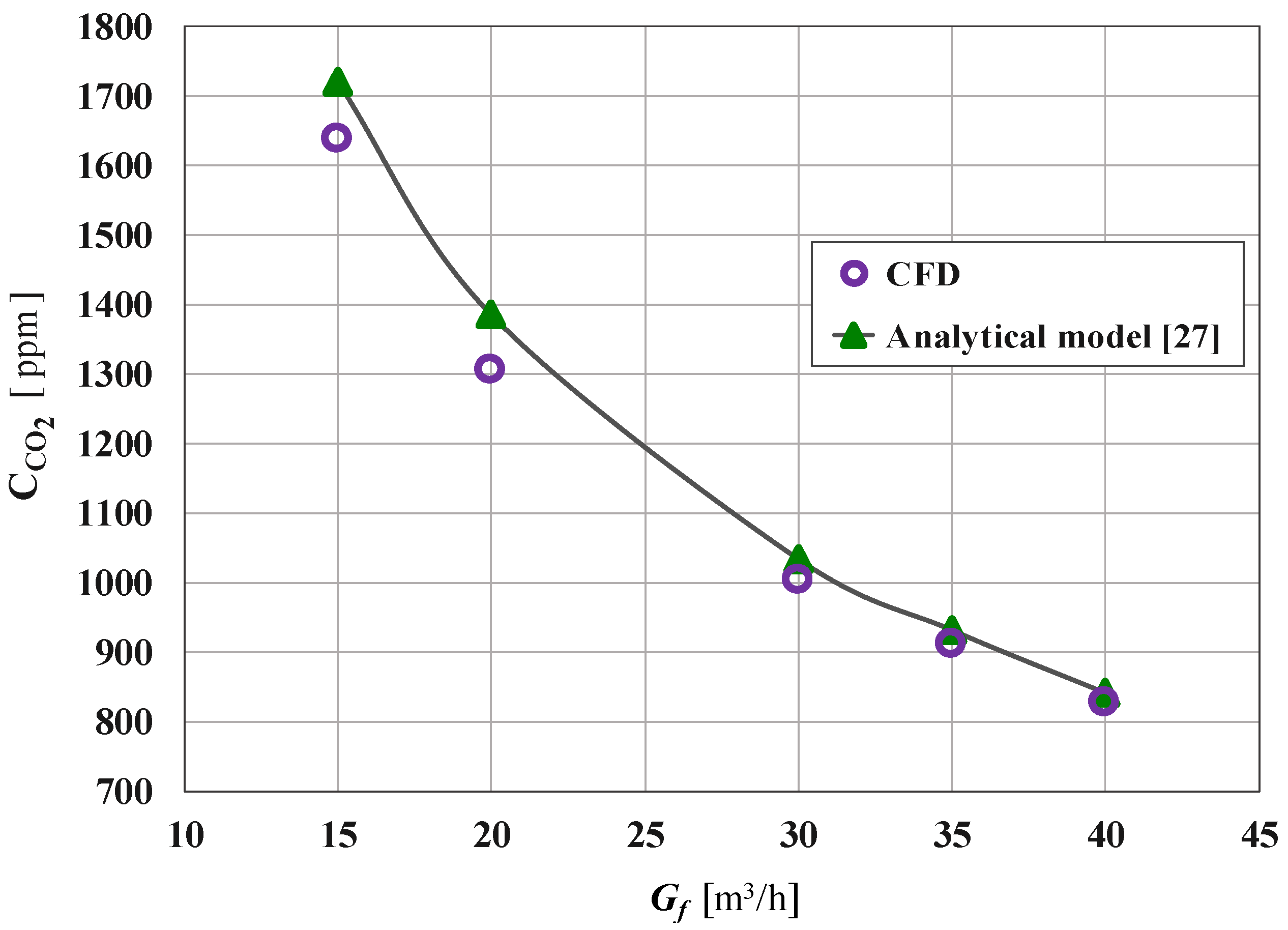


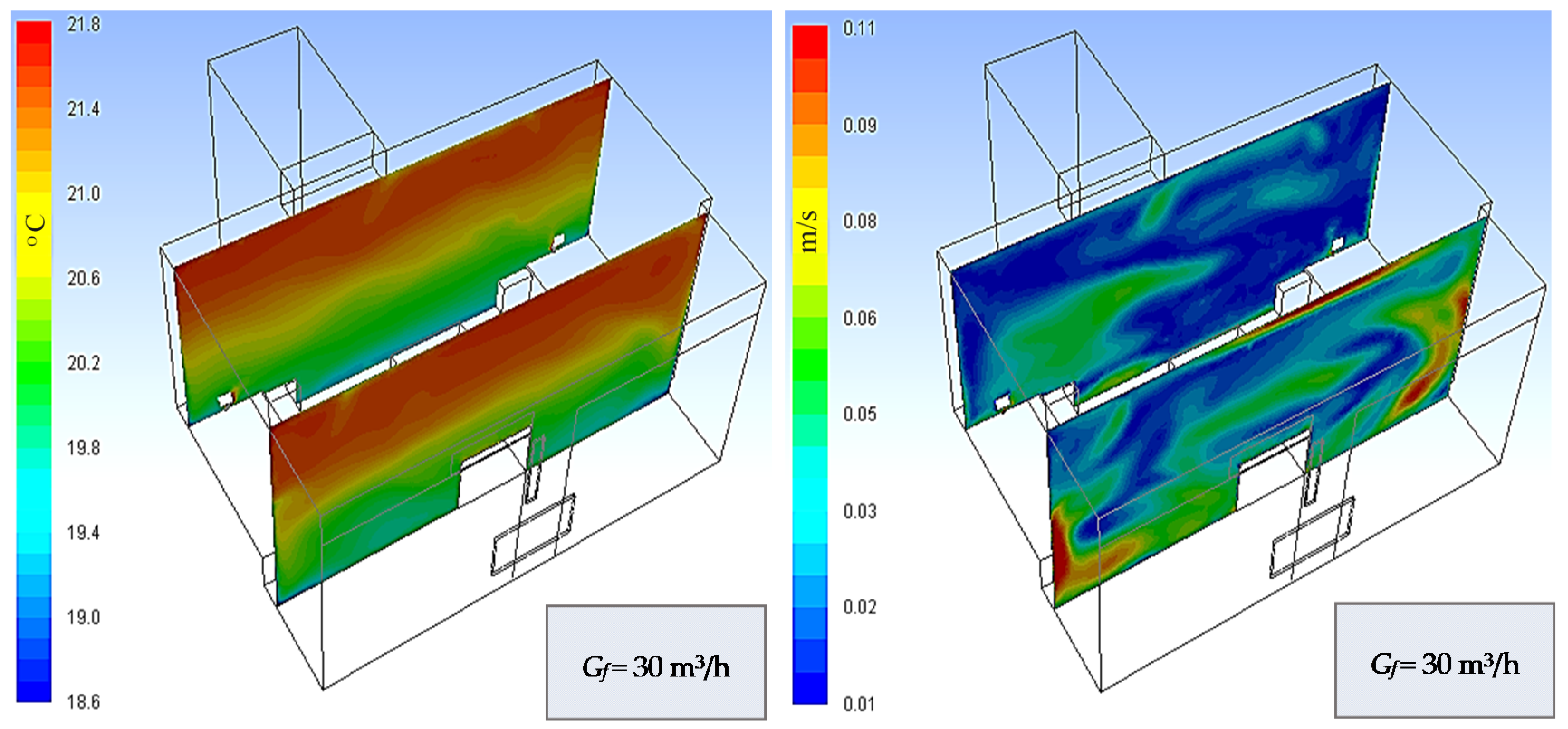


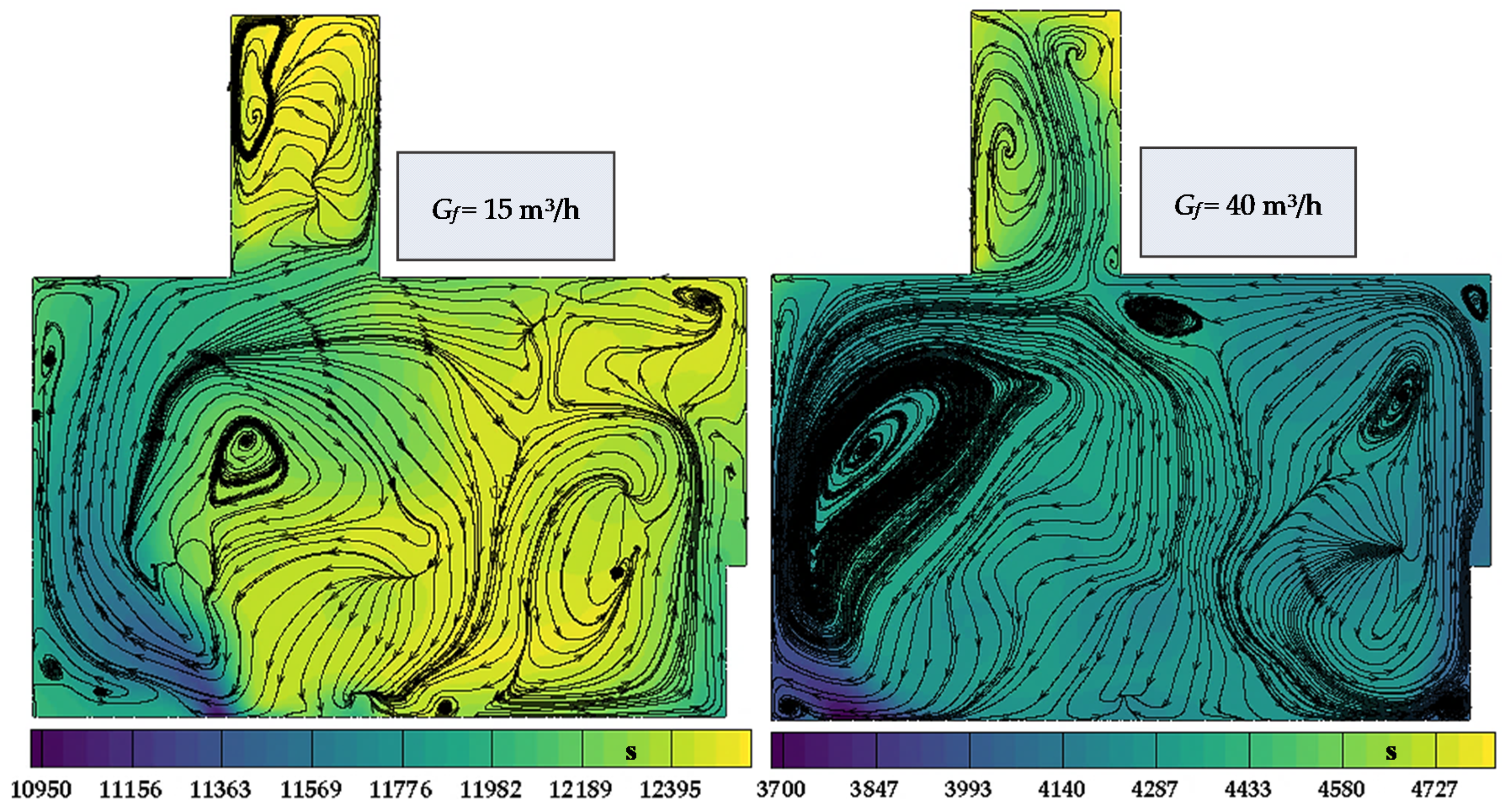



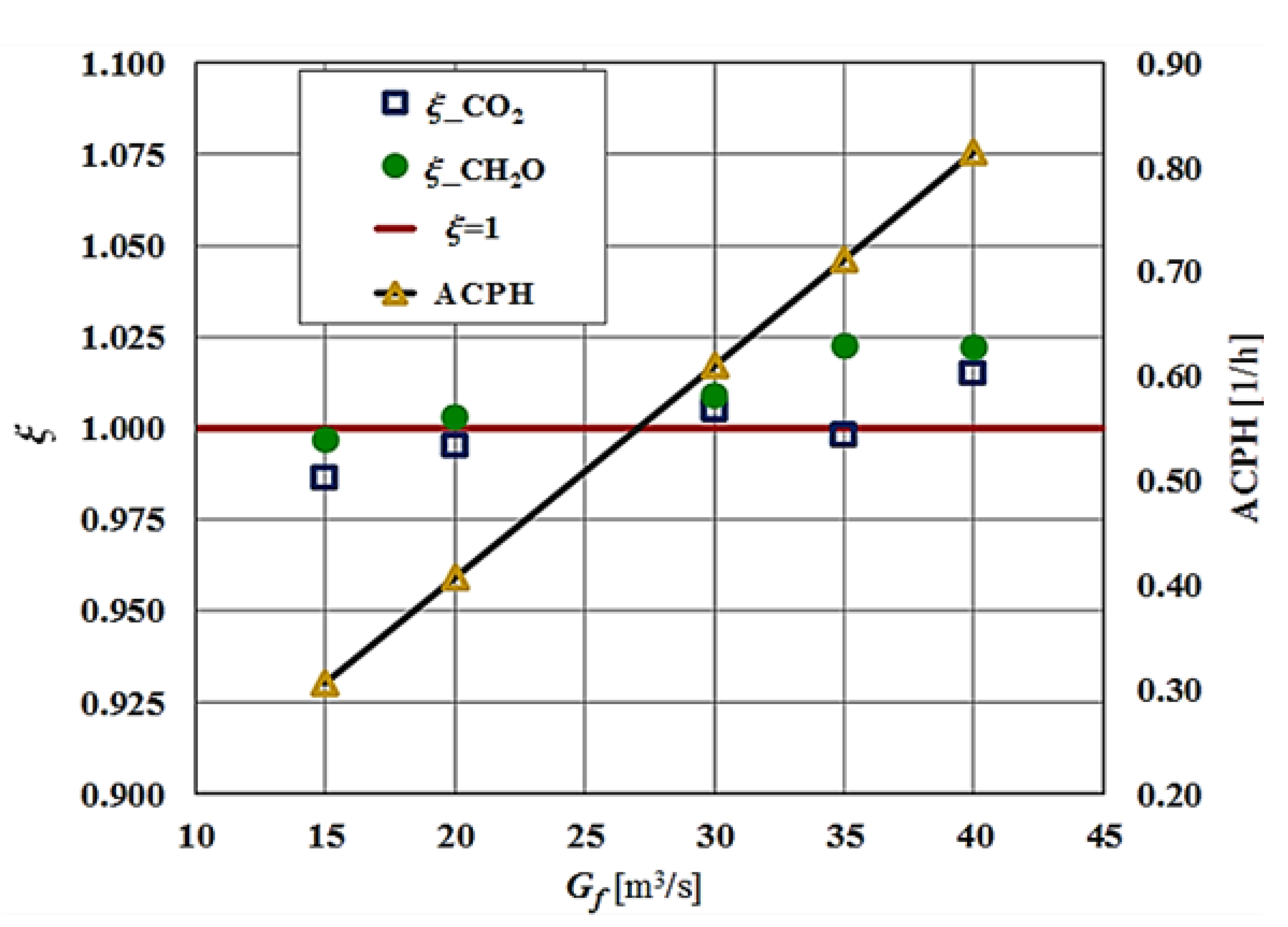


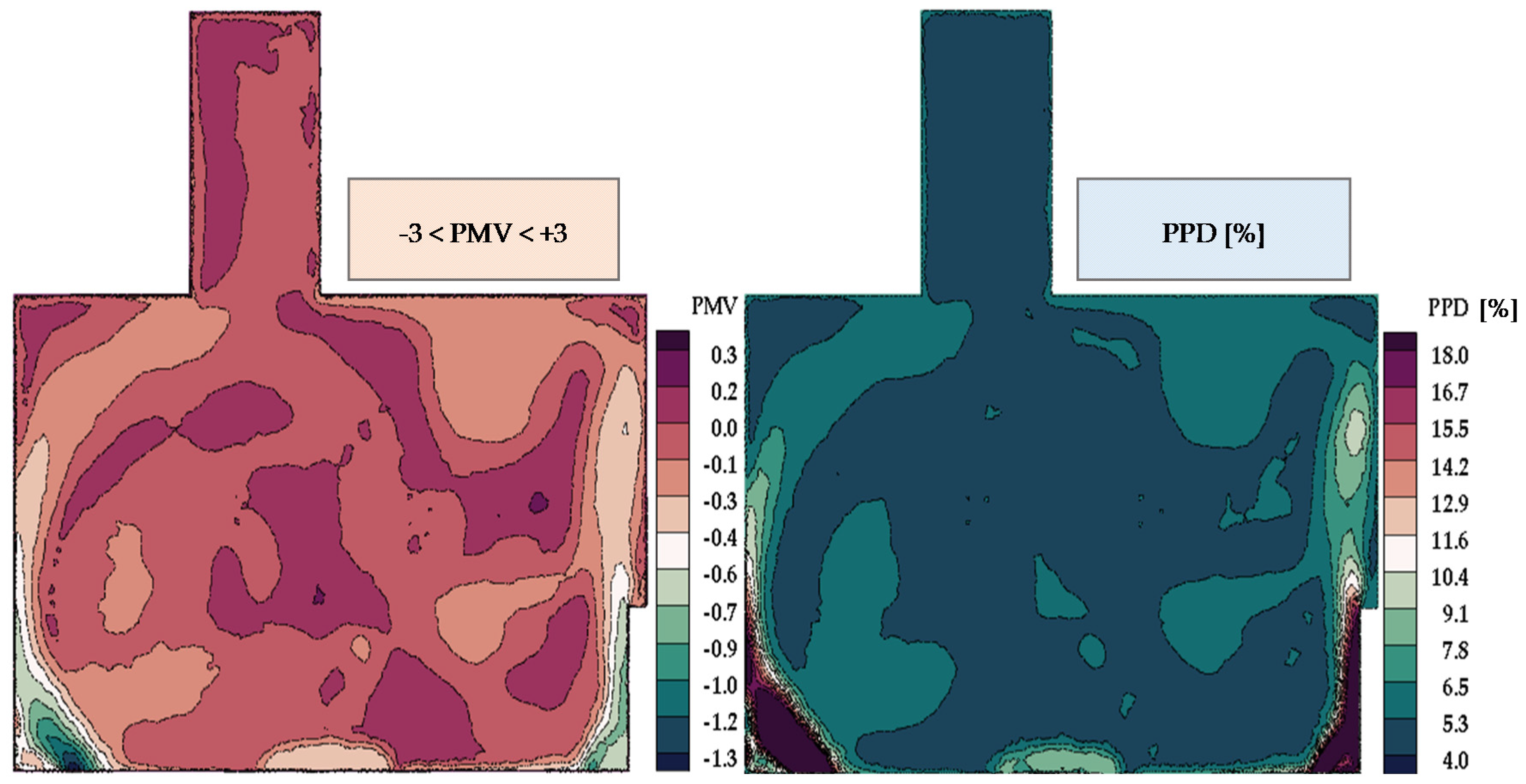


| Case | Air Flow Rate (Gf) [m3/h] | Mass Flow Rate [kg/s] | Air Velocity at Inlet [m/s] | Thermal Efficiency [%] |
|---|---|---|---|---|
| 1 | 15 | 0.005 | 0.80 | 82 |
| 2 | 20 | 0.007 | 1.07 | 78 |
| 3 | 30 | 0.010 | 1.61 | 74 |
| 4 | 35 | 0.012 | 1.87 | 72 |
| 5 | 40 | 0.014 | 2.19 | 69 |
| αk, αε | C1ε | C2ε | C*1ε | η | η0 | γ | Cμ |
|---|---|---|---|---|---|---|---|
| 1.39 | 1.42 | 1.68 | 4.377 | 0.012 | 0.0845 |
| Case | Gf [m3/h] | [°C] | [°C] | [m s−1] | I [%] |
|---|---|---|---|---|---|
| 1 | 15 | 20.97 | 20.64 | 0.026 | 0.92 |
| 2 | 20 | 20.91 | 20.60 | 0.029 | 0.97 |
| 3 | 30 | 20.78 | 20.51 | 0.034 | 1.06 |
| 4 | 35 | 20.69 | 20.46 | 0.037 | 1.13 |
| 5 | 40 | 20.58 | 20.36 | 0.041 | 1.22 |
| RH [%] | 40 | 50 | 60 | 70 | ||||||||
| Gf [m3/h] | 15 | 30 | 40 | 15 | 30 | 40 | 15 | 30 | 40 | 15 | 30 | 40 |
| PMV | −0.25 | −0.29 | −0.33 | −0.19 | −0.24 | −0.28 | −0.14 | −0.19 | −0.22 | −0.08 | −0.13 | −0.17 |
| PPD [%] | 6.27 | 6.80 | 7.25 | 5.77 | 6.20 | 6.59 | 5.39 | 5.73 | 6.03 | 5.14 | 5.37 | 5.60 |
Publisher’s Note: MDPI stays neutral with regard to jurisdictional claims in published maps and institutional affiliations. |
© 2020 by the authors. Licensee MDPI, Basel, Switzerland. This article is an open access article distributed under the terms and conditions of the Creative Commons Attribution (CC BY) license (http://creativecommons.org/licenses/by/4.0/).
Share and Cite
Jahanbin, A.; Semprini, G. Numerical Study on Indoor Environmental Quality in a Room Equipped with a Combined HRV and Radiator System. Sustainability 2020, 12, 10576. https://doi.org/10.3390/su122410576
Jahanbin A, Semprini G. Numerical Study on Indoor Environmental Quality in a Room Equipped with a Combined HRV and Radiator System. Sustainability. 2020; 12(24):10576. https://doi.org/10.3390/su122410576
Chicago/Turabian StyleJahanbin, Aminhossein, and Giovanni Semprini. 2020. "Numerical Study on Indoor Environmental Quality in a Room Equipped with a Combined HRV and Radiator System" Sustainability 12, no. 24: 10576. https://doi.org/10.3390/su122410576






